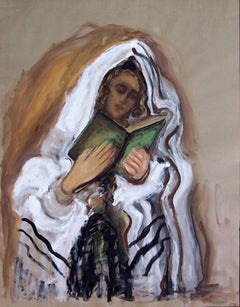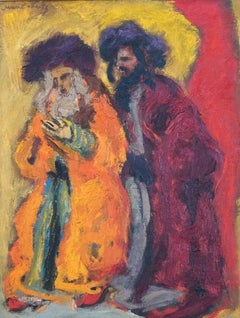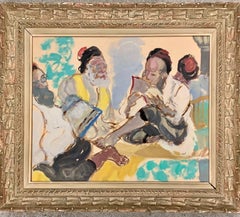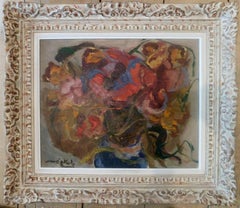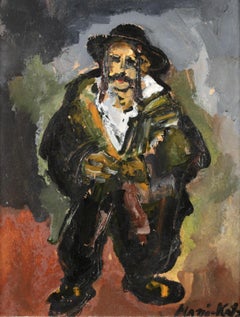Mane Katz Paintings
American, 1894-1962
Emmanuel Mané-Katz was a prominent modernist in Paris at the beginning of the twentieth century. He studied at the Beaux Arts Academy in Kyiv, Ukraine. After his extensive travels through Europe (catalyzed by World War I), Mané-Katz eventually settled in Paris, where he befriended Pablo Picasso and other fellow modernists. Many of Mané-Katz’s paintings have deep religious significance and origins, often picturing rabbis, Jewish students, and other Hassidic personas. Such paintings of Jewish folklore are often compared to Marc Chagall’s religiously-influenced art practice. He continued his travels to places like Israel, Palestine, Brazil, and Japan throughout the rest of his life, maintaining adherence to religious themes and portraiture in his art.
The Mané-Katz Museum is located on Mt. Carmel in Haifa, Israel, and his work is part of the permanent collections of the Tate, the MOMA, and the Museum of Art at Ein Harod in Israel. After his death, Mané-Katz donated much of his art to Haifa, Israel, where his home was. His participation in the School of Paris alongside modernists like Picasso, Chagall, and Soutine solidified him as an influential modernist painter in the early twentieth century.(Biography provided by Rafael Gallery)
to
4
3
1
4
2
1
4
1
Overall Height
to
Overall Width
to
3
1
1
6
5
2
2
1
1
1
1
1
1
1
1
1
7
1
1
22
863
657
650
610
7
4
3
3
1
Artist: Mane Katz
Praying Jew - Russian Art Ukrainian Jewish
By Mane Katz
Located in London, GB
This original painting is signed in pencil by the artist "Mane Katz" in the lower left corner.
Condition: Very good condition. Some waves on the paper, especially on the upper side ...
Category
20th Century Other Art Style Mane Katz Paintings
Materials
Watercolor, Gouache
Flowers - Russian Art Judaica
By Mane Katz
Located in London, GB
This painting is hand signed in oil by the artist "Mane-Katz" in the lower right corner.
It was probably painted in the 1950's.
Provenance: Christie's, London, 3rd December 1999, lo...
Category
1950s Other Art Style Mane Katz Paintings
Materials
Oil
Abstract Landscape with Palm Tree Judaica Gouache Painting
By Mane Katz
Located in Surfside, FL
Mane-Katz (1894-1962) Landscape with palm tree. Gouache on paper, signed lower right. Dimensions: (Frame) H 37.5" x W 31", (Sight) H 24.5" x W 18"
Emmanuel Mané-Katz (Hebrew:מאנה כ...
Category
20th Century Modern Mane Katz Paintings
Materials
Gouache
Rabbis
By Mane Katz
Located in Larchmont, NY
MANE-KATZ
RABBIS, c. 1935
Oil on canvas
18 H. x 14 W. 1/2 in. (45.5 x 35.8 cm.)
Signed
PROVENANCE
Dominion Gallery, Montreal
Christies, New York, November 04, 1982. Lot 177: $11,000
Private Collection, New Jersey, 1982-2021
Estate of the above, 2021.
Raised in an orthodox Jewish family in Russia, Mane-Katz was born in the Ukraine and became an early 20th-century artist, known especially for portraits and paintings with Jewish themes. From childhood, he had been influenced by stories of Jewish mysticism, which was reflected in his paintings.
He had a peripatetic life between Russia, France, Israel, and America. He first studied art in Kiev at the Beaux Arts Academy, and in 1913, went to Paris where he associated with Chaim Soutine and Marc Chagall and continued his art studies there at the Beaux Arts Academy.
During World War I, he tried to join the Foreign Legion but was rejected because he was too short. He went back in Russia again, this time joining the Soviet Revolution but rejected the cause because he was so horrified by Josef Stalin. He worked briefly for the Russian ballets, and in 1921, he returned to Paris where in 1927 he took French citizenship. For the next twelve years, he traveled widely, showing his art work and doing many paintings.
In 1939, as World War II was breaking out, he was drafted by the French and then was taken prisoner by the Germans. He escaped and went to the United States and remained there until 1945, exhibiting his paintings at Katia Granoff Gallery and Wildenstein Gallery. After the war, he returned to Paris where he had exhibited in the Salons. In Paris to the end of his career, he worked happily, painting hundreds of portraits of rabbis...
Category
Early 20th Century Fauvist Mane Katz Paintings
Materials
Canvas, Oil
Russian French Judaica Jewish Gouache Painting Sephardic Rabbi, Jerusalem Israel
By Mane Katz
Located in Surfside, FL
Mané-Katz (1894 - 1962)
SCHOLARS AT STUDY
Signed Mané Katz (lower right)
Tempera (gouache) on paper laid down on card.
19 3/4 by 23 5/8 in. (50.2 by 60.1 cm) sight size.
Frame size is 27 X 31 inches.
Provenance: Sotheby's Impressionist & Modern art, 8 June 2017 (consigned by original owner who purchased it directly from artist)
Mane-Katz (1894-1962) was a Litvak painter born in Ukraine best known for his depictions of the Jewish shtetl in Eastern Europe. Emmanuel Mané-Katz (Hebrew:מאנה כץ), born Mane Leyzerovich Kats (1894–1962), was a Litvak painter born in Kremenchuk, Ukraine, best known for his depictions of the Jewish shtetl in Eastern Europe. Particularly music figures and Jewish wedding scenes.
Mane-Katz moved to Paris at the age of 19 to study art, although his father wanted him to be a rabbi. During the First World War he returned to Russia, at first working and exhibiting in Petrograd; following the October revolution, he traveled back to Kremenchuk, where he taught art. In 1921, due to the ongoing fighting in his hometown during the civil war, he moved once again to Paris. There he became friends with Pablo Picasso and other important French artists, and was affiliated with the art movement known as the School of Paris; together with other outstanding Jewish artists of that milieu, he is sometimes considered to be part of a group referred to specifically as the Jewish School of Paris. Includes Russian, Ukrainian and Polish painters Jankel Adler, Arbit Blatas, Marc Chagall, Jacques Chapiro, Michel Kikoine, Pinchus Kremegne, Sigmund Menkes, Jules Pascin, Issachar Ryback, Jacques Lipchitz,Chana Orloff, and Ossip Zadkine. Ecole de Paris
In 1931, Mane-Katz's painting The Wailing Wall was awarded a gold medal at the Paris World's Fair. Early on, his style was classical and somber, but his palette changed in later years to bright, primary colors, with an emphasis on Jewish themes. His oils feature Judaic Hasidic characters, rabbis, Jewish musicians, beggars, yeshiva students and scenes from the East European shtetl made famous in the west by Sholem Aleichem and Tevye.
Mane-Katz made his first trip to Mandate Palestine in 1928, and thereafter visited the country annually. He said his actual home was Paris, but his spiritual home was Eretz Yisrael, the Land of Israel. In 1939, as World War II was breaking out, he was drafted by the French and then was taken prisoner by the Germans. He escaped and went to the United States and remained there until 1945, exhibiting his paintings at Katia Granoff Gallery and Wildenstein Gallery. After the war, he returned to Paris where he had exhibited in the Salons. In Paris to the end of his career, he worked happily, painting hundreds of portraits of rabbis...
Category
Mid-20th Century Modern Mane Katz Paintings
Materials
Tempera, Gouache
Vase of Flowers
By Mane Katz
Located in London, GB
MANE KATZ [Katz Emmanuel] 1894-1962
Kremenchug, Ukraine 1894-1962 Tel Aviv (Russian / Ukrainian / French / Israeli)
Title: Vase of Flowers
Tech...
Category
Early 20th Century Modern Mane Katz Paintings
Materials
Oil
Fishermen by the Boats - Maritime Seaside Coastal
By Mane Katz
Located in London, GB
MANE KATZ [Katz Emmanuel] 1894-1962
Kremenchug, Ukraine 1894-1962 Tel Aviv (Russian / Ukrainian / French / Israeli)
Title: Fishermen by the Boats, circa 1941
Techinique: Original Signed Oil Painting on Canvas
Size: 51 x 61 cm / 20.1 x 24 in
Additional Information: The work is signed "Mane Katz" on the right hand side.
This work was painted circa 1941.
Provenance:
Graham Gallery...
Category
1940s Expressionist Mane Katz Paintings
Materials
Oil
Related Items
La Vie Est Belle. 2023, oil on canvas, 80x70 cm
Located in Riga, LV
La Vie Est Belle. 2023, oil on canvas, 80x70 cm
Works of Liene Liepina are full of life and joy because of photography-like, realistic details on the one hand, and intense and slight...
Category
2010s Photorealist Mane Katz Paintings
Materials
Oil, Canvas
The Abduction of the Sabine Women , a Renaissance drawing by Biagio Pupini
Located in PARIS, FR
This vigorous drawing has long been attributed to Polidoro da Caravaggio: The Abduction of the Sabine Women is one of the scenes that Polidoro depicted between 1525 and 1527 on the façade of the Milesi Palazzo in Rome. However, the proximity to another drawing inspired by this same façade, kept at the Ecole des Beaux-Arts, and to other drawings inspired by Polidoro kept at the Musée du Louvre, leads us to propose an attribution to Biagio Pupini, a Bolognese artist whose life remains barely known, despite the abundant number of drawings attributed to him.
1. Biagio Pupini, a Bolognese artist in the light of the Roman Renaissance
The early life of Biagio Pupini, an important figure of the first half of the Cinquecento in Bologna - Vasari mentions him several times - is still poorly known. Neither his date of birth (probably around 1490-1495) nor his training are known. He is said to have been a pupil of Francesco Francia (1450 - 1517) and his name appears for the first time in 1511 in a contract with the painter Bagnacavallo (c. 1484 - 1542) for the frescoes of a church in Faenza. He then collaborated with Girolamo da Carpi, at San Michele in Bosco and at the villa of Belriguardo.
He must have gone to Rome for the first time with Bagnacavallo between 1511 and 1519. There he discovered the art of Raphael, with whom he might have worked, and that of Polidoro da Caravaggio. This first visit, and those that followed, were the occasion for an intense study of ancient and modern art, as illustrated by his abundant graphic production.
Polidoro da Caravaggio had a particular influence on the technique adopted by Pupini. Executed on coloured paper, his drawings generally combine pen, brown ink and wash with abundant highlights of white gouache, as in the drawing presented here.
2. The Abduction of the Sabine Women
Our drawing is an adaptation of a fresco painted between 1525 and 1527 by Polidoro da Caravaggio on the façade of the Milesi Palace in Rome. These painted façades were very famous from the moment they were painted and inspired many artists during their stay in Rome. These frescoes are now very deteriorated and difficult to see, as the palace is in a rather narrow street.
The episode of the abduction of the Sabine women (which appears in the centre of the photo above) is a historical theme that goes back to the origins of Rome and is recounted both by Titus Livius (Ab Urbe condita I,13), by Ovid (Fasti III, 199-228) and by Plutarch (II, Romulus 14-19). After killing his twin brother Romus, Romulus populates the city of Rome by opening it up to refugees and brigands and finds himself with an excess of men. Because of their reputation, none of the inhabitants of the neighbouring cities want to give them their daughters in marriage. The Romans then decide to invite their Sabine neighbours to a great feast during which they slaughter the Sabines and kidnap their daughters.
The engraving made by Giovanni Battista Gallestruzzi (1618 - 1677) around 1656-1658 gives us a good understanding of the Polidoro fresco, allowing us to see how Biagio Pupini reworked the scene to extract this dynamic group.
With a remarkable economy of means, Biagio Pupini takes over the left-hand side of the fresco and depicts in a very dense space two main groups, each consisting of a Roman and a Sabine, completed by a group of three soldiers in the background (which seems to differ quite significantly from Polidoro's composition).
The balance of the drawing is based on a very strongly structured composition. The drawing is organised around a median vertical axis, which runs along both the elbow of the kidnapped Sabine on the left and the foot of her captor, and the two main diagonals, reinforced by four secondary diagonals. This diamond-shaped structure creates an extremely dynamic space, in which centripetal movements (the legs of the Sabine on the right, the arm of the soldier on the back at the top right) and centrifugal movements (the arm of the kidnapper on the left and the legs of the Sabine he is carrying away, the arm of the Sabine on the right) oppose each other, giving the drawing the appearance of a whirlpool around a central point of support situated slightly to the left of the navel of the kidnapper on the right.
3. Polidoro da Caravaggio, and the decorations of Roman palaces
Polidoro da Caravaggio was a paradoxical artist who entered Raphael's (1483 - 1520) workshop at a very young age, when he oversaw the Lodges in the Vatican. Most of his Roman work, which was the peak of his career, has disappeared, as he specialised in facade painting, and yet these paintings, which are eminently visible in urban spaces, have influenced generations of artists who copied them abundantly during their visits to Rome.
Polidoro Caldara was born in Caravaggio around 1495-1500 (the birthplace of Michelangelo Merisi, known as Caravaggio, who was born there in 1571), some forty kilometres east of Milan. According to Vasari, he arrived as a mason on the Vatican's construction site and joined Raphael's workshop around 1517 (at the age of eighteen according to Vasari). This integration would have allowed Polidoro to work not only on the frescoes of the Lodges, but also on some of the frescoes of the Chambers, as well as on the flat of Cardinal Bibiena in the Vatican.
After Raphael's death in 1520, Polidoro worked first with Perin del Vaga before joining forces with Maturino of Florence (1490 - 1528), whom he had also known in Raphael's workshop. Together they specialised in the painting of palace façades. They were to produce some forty façades decorated with grisaille paintings imitating antique bas-reliefs.
The Sack of Rome in 1527, during which his friend Maturino was killed, led Polidoro to flee first to Naples (where he had already stayed in 1523), then to Messina. It was while he was preparing his return to the peninsula that he was murdered by one of his assistants, Tonno Calabrese, in 1543.
In his Vite, Vasari celebrated Polidoro as the greatest façade decorator of his time, noting that "there is no flat, palace, garden or villa in Rome that does not contain a work by Polidoro". Polidoro's facade decorations, most of which have disappeared as they were displayed in the open air, constitute the most important lost chapter of Roman art of the Cinquecento. The few surviving drawings of the painter can, however, give an idea of the original appearance of his murals and show that he was an artist of remarkable and highly original genius.
4. The façade of the Milesi Palace
Giovanni Antonio Milesi, who commissioned this palace, located not far from the Tiber, north of Piazza Navona, was a native of the Bergamo area, like Polidoro, with whom he maintained close friendly ties. Executed in the last years before the Sack of Rome, around 1526-1527, the decoration of Palazzo Milesi is considered Polidoro's greatest decorative success.
An engraving by Ernesto Maccari made at the end of the nineteenth century allows us to understand the general balance of this façade, which was still well preserved at the time. The frescoes were not entirely monochrome, but alternated elements in chiaroscuro simulating marble bas-reliefs and those in ochre simulating bronze and gold vases...
Category
16th Century Old Masters Mane Katz Paintings
Materials
Ink, Gouache, Pen
Belisama
By Oswaldo Vigas
Located in Palm Beach, FL
Predominantly recognized as a self-taught painter, he also worked in architectural murals, sculptures, ceramics, prints and drawings.
Vigas is one...
Category
1960s Cubist Mane Katz Paintings
Materials
Canvas, Oil, Gouache, Board
Large Gouache Original Painting Mother & Daughter Sandu Liberman Israeli Judaica
By Sandu Liberman
Located in Surfside, FL
framed 36 X 28 board 30 X 21.75
Sandu Liberman (Romanian-Israeli) was born in Yasi, Romania in 1923. between 1946 and 1953 he took part in the state art shows in Bucharest. in 1952 ...
Category
20th Century Modern Mane Katz Paintings
Materials
Gouache, Paper
Virgin Mary and child Jesus oil on board painting Christ
Located in Barcelona, Barcelona
Josep Lloveras Feliu (1922-2014) - Virgin Mary and child Jesus - Oil on panel
Oil measurements 60x49 cm.
Frame measurements 68x57 cm.
Josep Lloveras y Feliu, was a painter and sculp...
Category
1950s Fauvist Mane Katz Paintings
Materials
Board, Oil
Kees Van Dongen Circus Performers 1900s Vintage Vibrant Figure Fauvist Signed
By Kees van Dongen
Located in Milwaukee, WI
"Les Artistes du Cirque" is an original painting in ink, watercolor, and gouache on paper by leading Fauvist artist Kees Van Dongen, signed in the lower right. In the piece, two circus performers stand against against a wall. On the left, a pale woman in a blue leotard with red flowers on the shoulder stands with her arms crossed, looking out at the viewer. The painter fills in her tights with delicate white brushstrokes, lending them an almost iridescent appearance. Her strawberry blond hair is piled on top of her hair according to the fashion of the period. On the right, an African man stands in a vivid orange toga, looking somewhere off to the left. His feet are clad in bright white shoes...
Category
Early 1900s Fauvist Mane Katz Paintings
Materials
Paper, Ink, Watercolor, Gouache
Antique American Modernist Surreal Street Scene Unsigned Framed Oil Painting
Located in Buffalo, NY
Antique American modernist street scene painting. Oil on board, circa 1930. Unsigned. Image size, 24L x 20H. Housed in a period modern frame.
Category
1930s Modern Mane Katz Paintings
Materials
Canvas, Oil, Gouache
H 26 in W 30 in D 2 in
woman in white oil on canvas painting portrait
By Ignasi Mundó
Located in Barcelona, Barcelona
Ignasi Mundó Marcet (1918-2012) - woman in white - Oil on canvas
Canvas measures 73x60 cm.
Frame size 76x63 cm.
MUNDO Ignasi
Ignasi Mundó trained at the School of La Lonja, with Joa...
Category
1940s Fauvist Mane Katz Paintings
Materials
Canvas, Oil
Mid Century French Illustration Sketch Of Butterflies Wallpaper
Located in Cirencester, Gloucestershire
Josine Vignon (French 1922-2022) ...
Category
Mid-20th Century Impressionist Mane Katz Paintings
Materials
Gouache
No Reserve
H 25.5 in W 19.5 in D 1 in
Two Cooked Fish with Garnish - Still Life in Oil on Artist's Board
Located in Soquel, CA
Two Cooked Fish with Garnish - Still Life in Oil on Artist's Board
Still life of two fish by an unknown artist (20th Century). This piece is executed in a classical, painterly style...
Category
21st Century and Contemporary American Impressionist Mane Katz Paintings
Materials
Canvas, Plaster, Oil, Illustration Board
H 17 in W 21 in D 1 in
"Interior View into the Patio" Colorful Post-Impressionist Scene Painting Framed
By Jacques Zucker
Located in New York, NY
This painting depicts an interior scene done in Paris. The fun details are what make this painting so attractive and desirable; the living room opens out into the terrace, as we are ...
Category
20th Century Post-Impressionist Mane Katz Paintings
Materials
Archival Paper, Gouache
Waves and their Shadows, Bauhaus Geometric Patterns in Black, Primary Tones Hue
By Natalia Roman
Located in Barcelona, ES
This abstract geometric acrylic painting is a vibrant and playful composition that draws inspiration from vintage Italian parasols. With a focus on bold, bright colors and clean line...
Category
2010s Abstract Geometric Mane Katz Paintings
Materials
Oil Pastel, Oil, Acrylic, Watercolor, Gouache
Previously Available Items
An Hasidic Jew - Expressionist Portrait Oil Painting by Mane-Katz
By Mane Katz
Located in Marlow, Buckinghamshire
Signed oil on board expressionist portrait circa 1930 by French painter Mane-Katz. The piece depicts an Hasidic Jew which is a subject he is best know for.
Signature:
Signed lower right
Dimensions:
Framed: 16.5"x14.5"
Unframed: 10"x8"
Provenance:
Private French collection.
A certificate from Mr. Lucien Krief is available on request
Emmanuel Katz...
Category
Early 20th Century Expressionist Mane Katz Paintings
Materials
Oil, Board
Colorful original oil painting of flowers by Mane Katz
By Mane Katz
Located in Jerusalem, IL
A large and colorful oil on canvas painting of still life flowers, by the well-known artist Mana Katz.
comes with the original frame
Category
1920s Mane Katz Paintings
Materials
Oil
Abstract Landscape with Palm Tree Judaica Gouache Painting
By Mane Katz
Located in Surfside, FL
Mane-Katz (1894-1962) Landscape with palm tree. Gouache on paper, signed lower right. Dimensions: (Frame) H 37.5" x W 31", (Sight) H 24.5" x W 18"
Emmanuel Mané-Katz (Hebrew:מאנה כ...
Category
20th Century Modern Mane Katz Paintings
Materials
Gouache
Farm in the Vendée
By Mane Katz
Located in London, GB
50 x 55 cm (19 ¾ x 21 ⅝ inches)
Signed lower right, "Mané Katz"
Provenance
René Lavigne, Geneva
Literature
Jacques O’Hana and Robert S. Aries, The complete works of Mane K...
Category
20th Century Expressionist Mane Katz Paintings
Materials
Gouache, Paper
Mane Katz paintings for sale on 1stDibs.
Find a wide variety of authentic Mane Katz paintings available for sale on 1stDibs. You can also browse by medium to find art by Mane Katz in paint, oil paint, gouache and more. Much of the original work by this artist or collective was created during the 20th century and is mostly associated with the modern style. Not every interior allows for large Mane Katz paintings, so small editions measuring 15 inches across are available. Customers who are interested in this artist might also find the work of Fletcher Martin, Sylvia Rutkoff, and Sylvia Spicuzza. Mane Katz paintings prices can differ depending upon medium, time period and other attributes. On 1stDibs, the price for these items starts at $2,600 and tops out at $24,200, while the average work can sell for $14,000.
